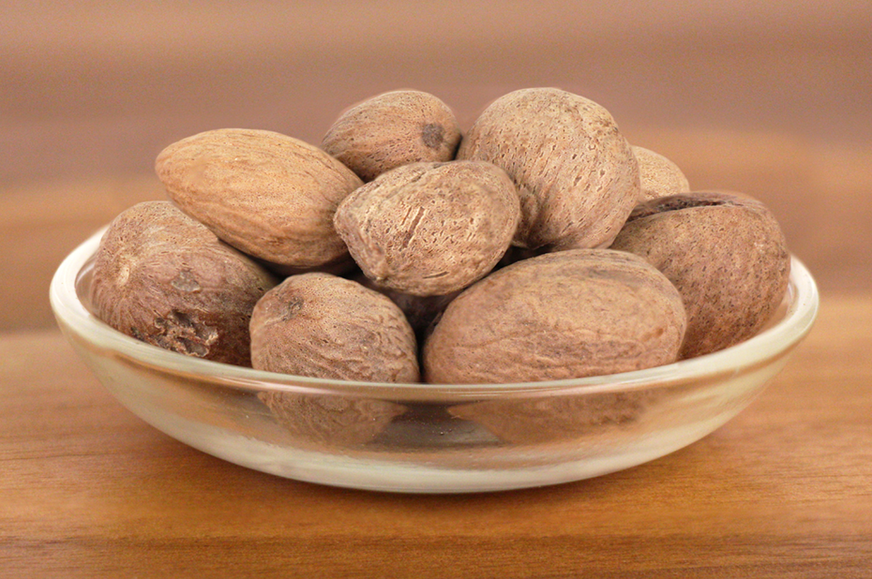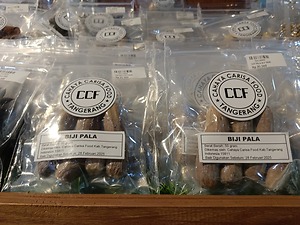


Whole Nutmeg
Estimated Inventory, 20 oz : 17.00
This item was last sold on : 07/05/25
Description/Taste
Whole Nutmeg seeds are oval and large in size, resembling a small walnut with an ashy brown hue. The exterior of the nutmeg seed is rough and covered in spidering ridges. The interior of the seed is hollow and streaked with dark-brown and rust-colored veins. Whole Nutmeg has a mild aroma that is warm and sweet. The seed cannot be consumed whole, but once ground, it releases a stronger aroma with notes of pine, citrus, and anise and has a warm and sweet flavor with a slight anesthetic quality that can create a numbing sensation on the palate.
Seasons/Availability
Whole Nutmeg is available year-round.
Current Facts
Whole Nutmeg is the pala fruit's inner seed, a drupe fruit resembling an apricot, produced by the tropical evergreen tree, Myristica fragrans. As the pala fruit ripens, it splits open to reveal a large seed surrounded by a red, stringy aril. This red webbing is harvested and sold as the spice mace. The fruit's seed is dried for 6 to 8 weeks in the sun until the inner seed separates from the outer shell. The inner Nutmeg seed is then harvested and soaked in lime to prevent it from sprouting and sold as Whole Nutmeg. The Nutmeg seeds can also be ground into a fine powder or pressed into oil and sold for use in soaps, perfumes, and culinary applications.
Nutritional Value
Nutmeg is a significant source of dietary fiber to aid in healthy digestion. Nutmeg is also a good source of vitamins A, C, and E and minerals such as manganese, magnesium, copper, and phosphorus. In high doses, the essential oil, myristicin, within Nutmeg can have psychoactive effects that can cause hallucinations and delirium. The spice can also be poisonous when consumed in large quantities causing nausea, headaches, and more severe reactions like respiratory distress, seizures, and even death.
Applications
Nutmeg is a popular spice worldwide, and its fragrant and warm spiciness lends itself to a variety of sweet and savory culinary applications. The aromatic spice is added to a variety of spice mixes, including pumpkin pie spice, garam masala, ras al hanout, and jerk seasoning. In Indonesia, Nutmeg is used to spice hearty soups and stews with oxtail and beef and to season slow-roasted pork dishes. The fragrant powder is added to mortadella sausage in Italy, and it is a key ingredient in the French mother sauce, bechamel, which is the base for many cream sauces used in pasta and casseroles. In American cuisine, the spice is often used in sweeter applications like pies, crumbles, cakes, and quick bread and cocktails like eggnog and mulled cider. Nutmeg pairs well with spinach, squash, and sage, as well as pork, lamb, and salty hard cheeses like parmesan. Whole Nutmeg must be ground before it is used. This can be done with a spice grinder or a microplane. Grind Nutmeg as needed and store the remaining seed in an airtight container away from any heat or light sources. Unground seeds can be stored for 1 to 3 years.
Ethnic/Cultural Info
The island of Grenada, located in the Caribbean Sea, is the world’s second-largest producer of Nutmeg, producing 20 percent of the world’s crop on just 134 square miles of land. The harvesting of Nutmeg provides income for 30 percent of the island’s population, and in its heyday, the island produced approximately 2,000 tons of spice per year with revenues of $13 million. The cultivation of the spice, known as “black gold” by the locals, is so significant that the country added a nutmeg seed to their flag in 1967. Tragically, Grenada was devastated by two large hurricanes in 2002 and 2004. The powerful winds from these hurricanes uprooted over 90 percent of the Nutmeg trees on the island. Nutmeg trees can take 5 to 6 years on average to fruit, and they can take up to 20 years to reach full production, so by 2011, the island had only recovered 15 percent of its original yield. Nutmeg trees have notoriously shallow root systems, and with strong hurricanes growing in number each year, the island is now faced with the challenge of protecting its new trees from future devastation. To meet this challenge, farmers have begun to create windbreaks and shelterbelts using bamboo, mango, and citrus trees and to intercrop with cocoa, banana, coconuts, and root crops to protect against soil erosion. In 2016, farmers on the island were introduced to grafting, which has allowed them to convert hundreds of male Nutmeg trees into fruit-bearing female trees, increasing yield. While the island still has a way to go to reach its peak production, in 2017, farmers harvested 1.3 million pounds of nutmeg, and in 2019, the island was the second-largest exporter to Europe, fulfilling 8% of the continent’s demand.
Geography/History
Nutmeg trees thrive on tropical, humid islands with sandy soil and are native to the Molucca Spice Islands of Indonesia. Evidence shows that the spice was discovered as early as the 1st century and traded throughout Constantinople by the 6th century. The spice was popular throughout antiquity in Egypt, Greece, and Rome for its fragrant properties. In the 12th century, Roman emperor Henry VI fumigated the streets of Rome with the aromatic before his coronation. The spice's origin remained a well-kept secret by Arab traders who controlled the trade and price of the highly sought-after spice until the 16th century when Portuguese explorers discovered the island of Banda, the primary source of Nutmeg and mace. By the 1600s, the Dutch had gained monopoly control of the spice trade from the Islands and maintained that control through wars, bloodshed, and genocide until 1810 when the British were finally able to smuggle a Nutmeg tree off the island and propagate it in Singapore, Sri Lanka, Sumatra, and Malaysia. Propagation of the spice has since spread to Zanzibar, East Africa, and the Caribbean Island of Grenada. Today, Indonesia and Grenada are the world’s largest producers and exporters of Nutmeg and mace. Whole Nutmeg can be found in the spice aisle of any grocery store or supermarket.
Featured Restaurants
Restaurants currently purchasing this product as an ingredient for their menu.
| Born & Raised (Bar) | San Diego CA | 619-550-5412 |
| The Victorian at Hill Street | Oceanside CA | 442-266-8285 |
| Raised By Wolves | San Diego CA | 916-207-1076 |
Recipe Ideas
Recipes that include Whole Nutmeg. One
| Cooked |
|
Pasta with Caesar's mushrooms |








